window FORD EXCURSION 2002 1.G Owner's Manual
[x] Cancel search | Manufacturer: FORD, Model Year: 2002, Model line: EXCURSION, Model: FORD EXCURSION 2002 1.GPages: 272, PDF Size: 5.06 MB
Page 156 of 272
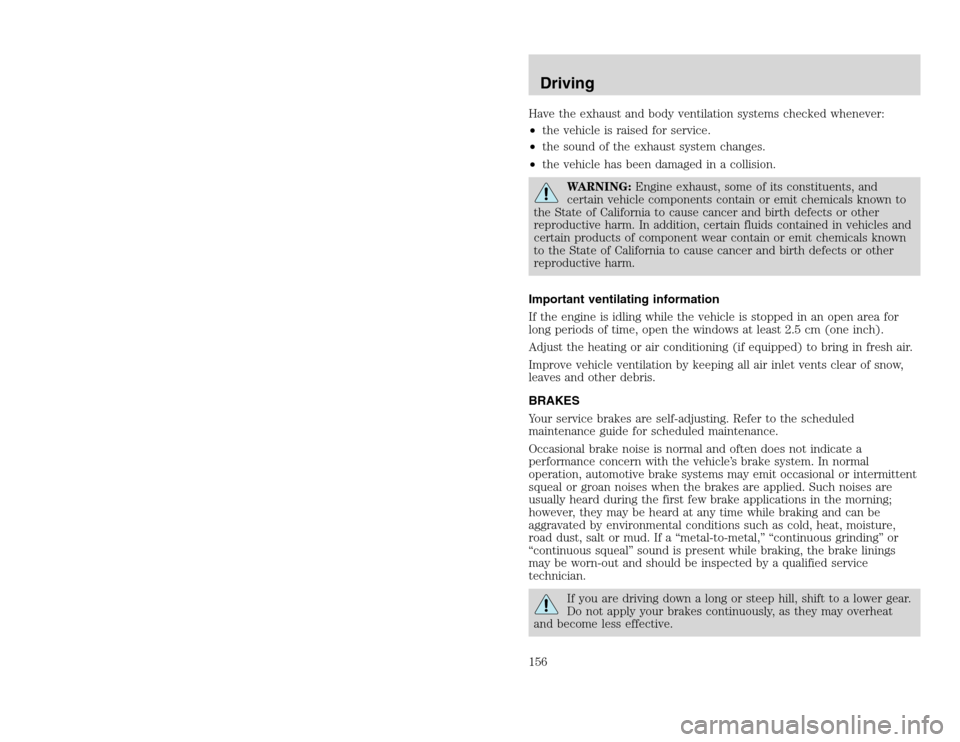
20815.psp Ford O/G 2002 Excursion English 4th Print 2C3J-19A321-HB 04/24/2003 09:14:57 78 B
Have the exhaust and body ventilation systems checked whenever:
•the vehicle is raised for service.
•the sound of the exhaust system changes.
•the vehicle has been damaged in a collision.
WARNING:Engine exhaust, some of its constituents, and
certain vehicle components contain or emit chemicals known to
the State of California to cause cancer and birth defects or other
reproductive harm. In addition, certain fluids contained in vehicles and
certain products of component wear contain or emit chemicals known
to the State of California to cause cancer and birth defects or other
reproductive harm.
Important ventilating information
If the engine is idling while the vehicle is stopped in an open area for
long periods of time, open the windows at least 2.5 cm (one inch).
Adjust the heating or air conditioning (if equipped) to bring in fresh air.
Improve vehicle ventilation by keeping all air inlet vents clear of snow,
leaves and other debris.
BRAKES
Your service brakes are self-adjusting. Refer to the scheduled
maintenance guide for scheduled maintenance.
Occasional brake noise is normal and often does not indicate a
performance concern with the vehicle’s brake system. In normal
operation, automotive brake systems may emit occasional or intermittent
squeal or groan noises when the brakes are applied. Such noises are
usually heard during the first few brake applications in the morning;
however, they may be heard at any time while braking and can be
aggravated by environmental conditions such as cold, heat, moisture,
road dust, salt or mud. If a “metal-to-metal,” “continuous grinding” or
“continuous squeal” sound is present while braking, the brake linings
may be worn-out and should be inspected by a qualified service
technician.If you are driving down a long or steep hill, shift to a lower gear.
Do not apply your brakes continuously, as they may overheat
and become less effective.
Driving156
Have the exhaust and body ventilation systems checked whenever:
•the vehicle is raised for service.
•the sound of the exhaust system changes.
•the vehicle has been damaged in a collision.
WARNING:Engine exhaust, some of its constituents, and
certain vehicle components contain or emit chemicals known to
the State of California to cause cancer and birth defects or other
reproductive harm. In addition, certain fluids contained in vehicles and
certain products of component wear contain or emit chemicals known
to the State of California to cause cancer and birth defects or other
reproductive harm.
Important ventilating information
If the engine is idling while the vehicle is stopped in an open area for
long periods of time, open the windows at least 2.5 cm (one inch).
Adjust the heating or air conditioning (if equipped) to bring in fresh air.
Improve vehicle ventilation by keeping all air inlet vents clear of snow,
leaves and other debris.
BRAKES
Your service brakes are self-adjusting. Refer to the scheduled
maintenance guide for scheduled maintenance.
Occasional brake noise is normal and often does not indicate a
performance concern with the vehicle’s brake system. In normal
operation, automotive brake systems may emit occasional or intermittent
squeal or groan noises when the brakes are applied. Such noises are
usually heard during the first few brake applications in the morning;
however, they may be heard at any time while braking and can be
aggravated by environmental conditions such as cold, heat, moisture,
road dust, salt or mud. If a “metal-to-metal,” “continuous grinding” or
“continuous squeal” sound is present while braking, the brake linings
may be worn-out and should be inspected by a qualified service
technician.If you are driving down a long or steep hill, shift to a lower gear.
Do not apply your brakes continuously, as they may overheat
and become less effective.
Driving156
Page 192 of 272
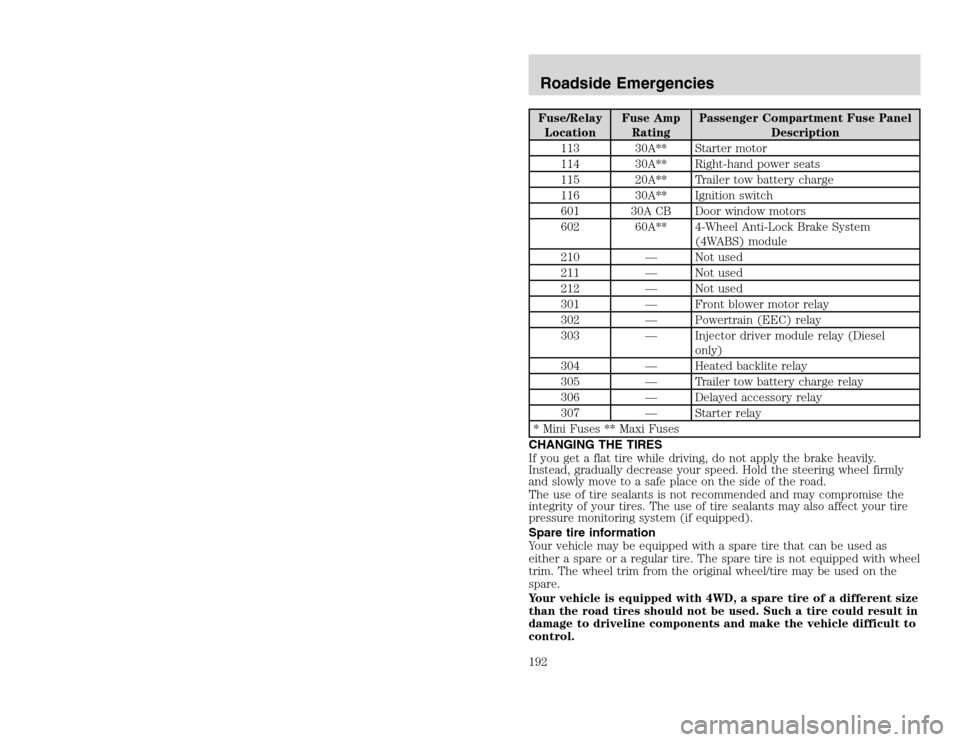
20815.psp Ford O/G 2002 Excursion English 4th Print 2C3J-19A321-HB 04/24/2003 09:14:57 96 B
Fuse/Relay
LocationFuse Amp
RatingPassenger Compartment Fuse Panel
Description
113 30A** Starter motor
114 30A** Right-hand power seats
115 20A** Trailer tow battery charge
116 30A** Ignition switch
601 30A CB Door window motors
602 60A** 4-Wheel Anti-Lock Brake System
(4WABS) module
210 — Not used
211 — Not used
212 — Not used
301 — Front blower motor relay
302 — Powertrain (EEC) relay
303 — Injector driver module relay (Diesel
only)
304 — Heated backlite relay
305 — Trailer tow battery charge relay
306 — Delayed accessory relay
307 — Starter relay
* Mini Fuses ** Maxi Fuses
CHANGING THE TIRES
If you get a flat tire while driving, do not apply the brake heavily.
Instead, gradually decrease your speed. Hold the steering wheel firmly
and slowly move to a safe place on the side of the road.
The use of tire sealants is not recommended and may compromise the
integrity of your tires. The use of tire sealants may also affect your tire
pressure monitoring system (if equipped).
Spare tire information
Your vehicle may be equipped with a spare tire that can be used as
either a spare or a regular tire. The spare tire is not equipped with wheel
trim. The wheel trim from the original wheel/tire may be used on the
spare.
Your vehicle is equipped with 4WD, a spare tire of a different size
than the road tires should not be used. Such a tire could result in
damage to driveline components and make the vehicle difficult to
control.Roadside Emergencies192
Fuse/Relay
LocationFuse Amp
RatingPassenger Compartment Fuse Panel
Description
113 30A** Starter motor
114 30A** Right-hand power seats
115 20A** Trailer tow battery charge
116 30A** Ignition switch
601 30A CB Door window motors
602 60A** 4-Wheel Anti-Lock Brake System
(4WABS) module
210 — Not used
211 — Not used
212 — Not used
301 — Front blower motor relay
302 — Powertrain (EEC) relay
303 — Injector driver module relay (Diesel
only)
304 — Heated backlite relay
305 — Trailer tow battery charge relay
306 — Delayed accessory relay
307 — Starter relay
* Mini Fuses ** Maxi Fuses
CHANGING THE TIRES
If you get a flat tire while driving, do not apply the brake heavily.
Instead, gradually decrease your speed. Hold the steering wheel firmly
and slowly move to a safe place on the side of the road.
The use of tire sealants is not recommended and may compromise the
integrity of your tires. The use of tire sealants may also affect your tire
pressure monitoring system (if equipped).
Spare tire information
Your vehicle may be equipped with a spare tire that can be used as
either a spare or a regular tire. The spare tire is not equipped with wheel
trim. The wheel trim from the original wheel/tire may be used on the
spare.
Your vehicle is equipped with 4WD, a spare tire of a different size
than the road tires should not be used. Such a tire could result in
damage to driveline components and make the vehicle difficult to
control.Roadside Emergencies192
Page 215 of 272
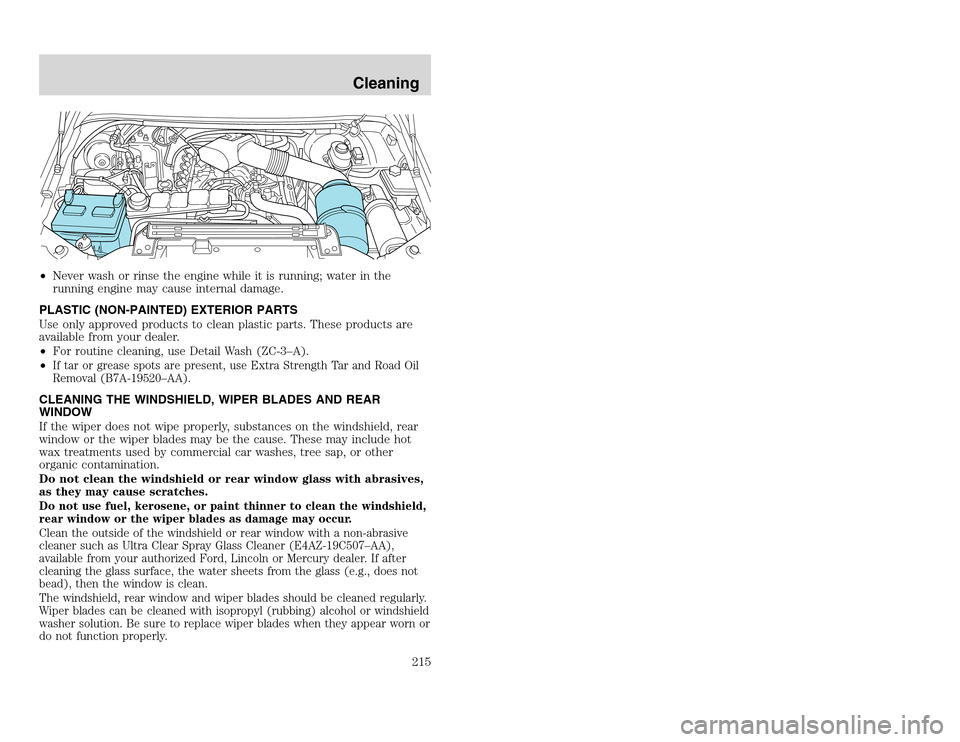
20815.psp Ford O/G 2002 Excursion English 4th Print 2C3J-19A321-HB 04/24/2003 09:14:57 108 A
•Never wash or rinse the engine while it is running; water in the
running engine may cause internal damage.
PLASTIC (NON-PAINTED) EXTERIOR PARTS
Use only approved products to clean plastic parts. These products are
available from your dealer.
•For routine cleaning, use Detail Wash (ZC-3–A).
•
If tar or grease spots are present, use Extra Strength Tar and Road Oil
Removal (B7A-19520–AA).
CLEANING THE WINDSHIELD, WIPER BLADES AND REAR
WINDOW
If the wiper does not wipe properly, substances on the windshield, rear
window or the wiper blades may be the cause. These may include hot
wax treatments used by commercial car washes, tree sap, or other
organic contamination.
Do not clean the windshield or rear window glass with abrasives,
as they may cause scratches.Do not use fuel, kerosene, or paint thinner to clean the windshield,
rear window or the wiper blades as damage may occur.
Clean the outside of the windshield or rear window with a non-abrasive
cleaner such as Ultra Clear Spray Glass Cleaner (E4AZ-19C507–AA),
available from your authorized Ford, Lincoln or Mercury dealer. If after
cleaning the glass surface, the water sheets from the glass (e.g., does not
bead), then the window is clean.
The windshield, rear window and wiper blades should be cleaned regularly.
Wiper blades can be cleaned with isopropyl (rubbing) alcohol or windshield
washer solution. Be sure to replace wiper blades when they appear worn or
do not function properly.
Cleaning
215
•Never wash or rinse the engine while it is running; water in the
running engine may cause internal damage.
PLASTIC (NON-PAINTED) EXTERIOR PARTS
Use only approved products to clean plastic parts. These products are
available from your dealer.
•For routine cleaning, use Detail Wash (ZC-3–A).
•
If tar or grease spots are present, use Extra Strength Tar and Road Oil
Removal (B7A-19520–AA).
CLEANING THE WINDSHIELD, WIPER BLADES AND REAR
WINDOW
If the wiper does not wipe properly, substances on the windshield, rear
window or the wiper blades may be the cause. These may include hot
wax treatments used by commercial car washes, tree sap, or other
organic contamination.
Do not clean the windshield or rear window glass with abrasives,
as they may cause scratches.Do not use fuel, kerosene, or paint thinner to clean the windshield,
rear window or the wiper blades as damage may occur.
Clean the outside of the windshield or rear window with a non-abrasive
cleaner such as Ultra Clear Spray Glass Cleaner (E4AZ-19C507–AA),
available from your authorized Ford, Lincoln or Mercury dealer. If after
cleaning the glass surface, the water sheets from the glass (e.g., does not
bead), then the window is clean.
The windshield, rear window and wiper blades should be cleaned regularly.
Wiper blades can be cleaned with isopropyl (rubbing) alcohol or windshield
washer solution. Be sure to replace wiper blades when they appear worn or
do not function properly.
Cleaning
215
Page 216 of 272
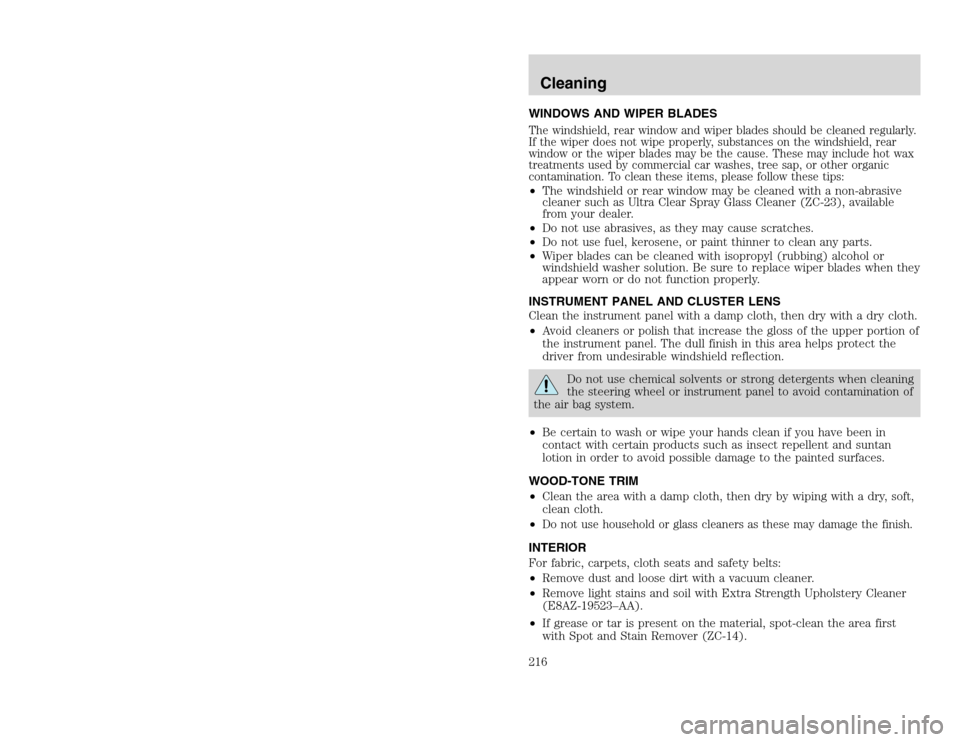
20815.psp Ford O/G 2002 Excursion English 4th Print 2C3J-19A321-HB 04/24/2003 09:14:57 108 B
WINDOWS AND WIPER BLADESThe windshield, rear window and wiper blades should be cleaned regularly.
If the wiper does not wipe properly, substances on the windshield, rear
window or the wiper blades may be the cause. These may include hot wax
treatments used by commercial car washes, tree sap, or other organic
contamination. To clean these items, please follow these tips:•The windshield or rear window may be cleaned with a non-abrasive
cleaner such as Ultra Clear Spray Glass Cleaner (ZC-23), available
from your dealer.
•Do not use abrasives, as they may cause scratches.
•Do not use fuel, kerosene, or paint thinner to clean any parts.
•Wiper blades can be cleaned with isopropyl (rubbing) alcohol or
windshield washer solution. Be sure to replace wiper blades when they
appear worn or do not function properly.
INSTRUMENT PANEL AND CLUSTER LENS
Clean the instrument panel with a damp cloth, then dry with a dry cloth.
•Avoid cleaners or polish that increase the gloss of the upper portion of
the instrument panel. The dull finish in this area helps protect the
driver from undesirable windshield reflection.
Do not use chemical solvents or strong detergents when cleaning
the steering wheel or instrument panel to avoid contamination of
the air bag system.
•Be certain to wash or wipe your hands clean if you have been in
contact with certain products such as insect repellent and suntan
lotion in order to avoid possible damage to the painted surfaces.
WOOD-TONE TRIM
•Clean the area with a damp cloth, then dry by wiping with a dry, soft,
clean cloth.
•
Do not use household or glass cleaners as these may damage the finish.
INTERIOR
For fabric, carpets, cloth seats and safety belts:
•Remove dust and loose dirt with a vacuum cleaner.
•Remove light stains and soil with Extra Strength Upholstery Cleaner
(E8AZ-19523–AA).
•If grease or tar is present on the material, spot-clean the area first
with Spot and Stain Remover (ZC-14).Cleaning216
WINDOWS AND WIPER BLADESThe windshield, rear window and wiper blades should be cleaned regularly.
If the wiper does not wipe properly, substances on the windshield, rear
window or the wiper blades may be the cause. These may include hot wax
treatments used by commercial car washes, tree sap, or other organic
contamination. To clean these items, please follow these tips:•The windshield or rear window may be cleaned with a non-abrasive
cleaner such as Ultra Clear Spray Glass Cleaner (ZC-23), available
from your dealer.
•Do not use abrasives, as they may cause scratches.
•Do not use fuel, kerosene, or paint thinner to clean any parts.
•Wiper blades can be cleaned with isopropyl (rubbing) alcohol or
windshield washer solution. Be sure to replace wiper blades when they
appear worn or do not function properly.
INSTRUMENT PANEL AND CLUSTER LENS
Clean the instrument panel with a damp cloth, then dry with a dry cloth.
•Avoid cleaners or polish that increase the gloss of the upper portion of
the instrument panel. The dull finish in this area helps protect the
driver from undesirable windshield reflection.
Do not use chemical solvents or strong detergents when cleaning
the steering wheel or instrument panel to avoid contamination of
the air bag system.
•Be certain to wash or wipe your hands clean if you have been in
contact with certain products such as insect repellent and suntan
lotion in order to avoid possible damage to the painted surfaces.
WOOD-TONE TRIM
•Clean the area with a damp cloth, then dry by wiping with a dry, soft,
clean cloth.
•
Do not use household or glass cleaners as these may damage the finish.
INTERIOR
For fabric, carpets, cloth seats and safety belts:
•Remove dust and loose dirt with a vacuum cleaner.
•Remove light stains and soil with Extra Strength Upholstery Cleaner
(E8AZ-19523–AA).
•If grease or tar is present on the material, spot-clean the area first
with Spot and Stain Remover (ZC-14).Cleaning216
Page 240 of 272
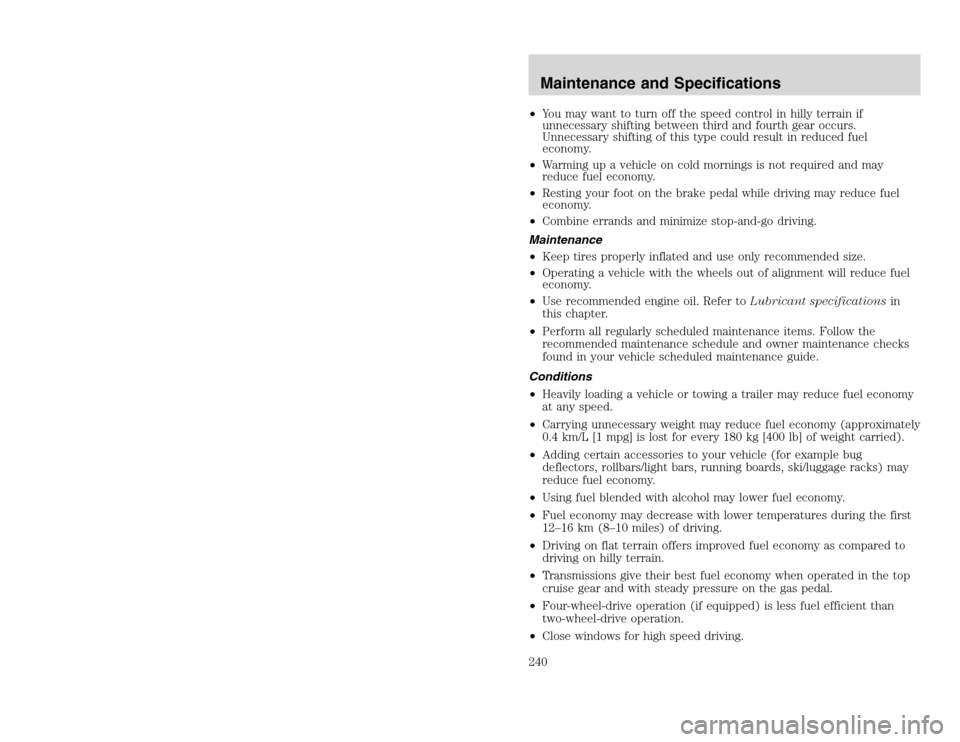
20815.psp Ford O/G 2002 Excursion English 4th Print 2C3J-19A321-HB 04/24/2003 09:14:57 120 B
•You may want to turn off the speed control in hilly terrain if
unnecessary shifting between third and fourth gear occurs.
Unnecessary shifting of this type could result in reduced fuel
economy.
•Warming up a vehicle on cold mornings is not required and may
reduce fuel economy.
•Resting your foot on the brake pedal while driving may reduce fuel
economy.
•Combine errands and minimize stop-and-go driving.
Maintenance
•Keep tires properly inflated and use only recommended size.
•Operating a vehicle with the wheels out of alignment will reduce fuel
economy.
•Use recommended engine oil. Refer toLubricant specificationsin
this chapter.
•Perform all regularly scheduled maintenance items. Follow the
recommended maintenance schedule and owner maintenance checks
found in your vehicle scheduled maintenance guide.
Conditions
•Heavily loading a vehicle or towing a trailer may reduce fuel economy
at any speed.
•Carrying unnecessary weight may reduce fuel economy (approximately
0.4 km/L [1 mpg] is lost for every 180 kg [400 lb] of weight carried).
•Adding certain accessories to your vehicle (for example bug
deflectors, rollbars/light bars, running boards, ski/luggage racks) may
reduce fuel economy.
•Using fuel blended with alcohol may lower fuel economy.
•Fuel economy may decrease with lower temperatures during the first
12–16 km (8–10 miles) of driving.
•Driving on flat terrain offers improved fuel economy as compared to
driving on hilly terrain.
•Transmissions give their best fuel economy when operated in the top
cruise gear and with steady pressure on the gas pedal.
•Four-wheel-drive operation (if equipped) is less fuel efficient than
two-wheel-drive operation.
•Close windows for high speed driving.Maintenance and Specifications240
•You may want to turn off the speed control in hilly terrain if
unnecessary shifting between third and fourth gear occurs.
Unnecessary shifting of this type could result in reduced fuel
economy.
•Warming up a vehicle on cold mornings is not required and may
reduce fuel economy.
•Resting your foot on the brake pedal while driving may reduce fuel
economy.
•Combine errands and minimize stop-and-go driving.
Maintenance
•Keep tires properly inflated and use only recommended size.
•Operating a vehicle with the wheels out of alignment will reduce fuel
economy.
•Use recommended engine oil. Refer toLubricant specificationsin
this chapter.
•Perform all regularly scheduled maintenance items. Follow the
recommended maintenance schedule and owner maintenance checks
found in your vehicle scheduled maintenance guide.
Conditions
•Heavily loading a vehicle or towing a trailer may reduce fuel economy
at any speed.
•Carrying unnecessary weight may reduce fuel economy (approximately
0.4 km/L [1 mpg] is lost for every 180 kg [400 lb] of weight carried).
•Adding certain accessories to your vehicle (for example bug
deflectors, rollbars/light bars, running boards, ski/luggage racks) may
reduce fuel economy.
•Using fuel blended with alcohol may lower fuel economy.
•Fuel economy may decrease with lower temperatures during the first
12–16 km (8–10 miles) of driving.
•Driving on flat terrain offers improved fuel economy as compared to
driving on hilly terrain.
•Transmissions give their best fuel economy when operated in the top
cruise gear and with steady pressure on the gas pedal.
•Four-wheel-drive operation (if equipped) is less fuel efficient than
two-wheel-drive operation.
•Close windows for high speed driving.Maintenance and Specifications240
Page 241 of 272
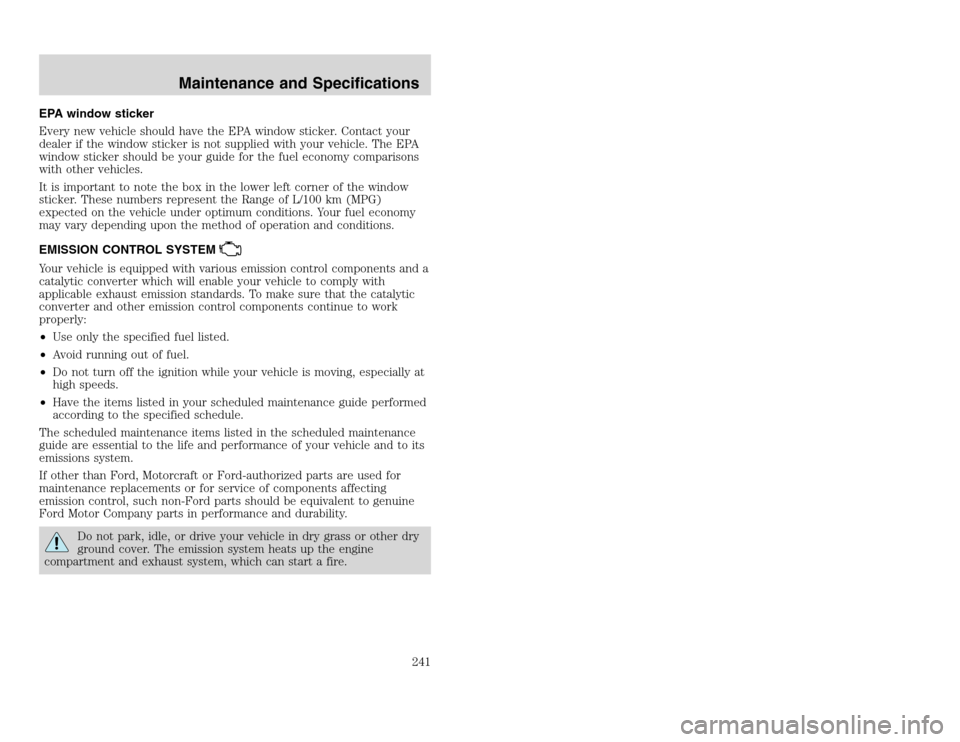
20815.psp Ford O/G 2002 Excursion English 4th Print 2C3J-19A321-HB 04/24/2003 09:14:57 121 A
EPA window sticker
Every new vehicle should have the EPA window sticker. Contact your
dealer if the window sticker is not supplied with your vehicle. The EPA
window sticker should be your guide for the fuel economy comparisons
with other vehicles.
It is important to note the box in the lower left corner of the window
sticker. These numbers represent the Range of L/100 km (MPG)
expected on the vehicle under optimum conditions. Your fuel economy
may vary depending upon the method of operation and conditions.
EMISSION CONTROL SYSTEMYour vehicle is equipped with various emission control components and a
catalytic converter which will enable your vehicle to comply with
applicable exhaust emission standards. To make sure that the catalytic
converter and other emission control components continue to work
properly:
•Use only the specified fuel listed.
•Avoid running out of fuel.
•Do not turn off the ignition while your vehicle is moving, especially at
high speeds.
•Have the items listed in your scheduled maintenance guide performed
according to the specified schedule.
The scheduled maintenance items listed in the scheduled maintenance
guide are essential to the life and performance of your vehicle and to its
emissions system.
If other than Ford, Motorcraft or Ford-authorized parts are used for
maintenance replacements or for service of components affecting
emission control, such non-Ford parts should be equivalent to genuine
Ford Motor Company parts in performance and durability.
Do not park, idle, or drive your vehicle in dry grass or other dry
ground cover. The emission system heats up the engine
compartment and exhaust system, which can start a fire.
Maintenance and Specifications
241
EPA window sticker
Every new vehicle should have the EPA window sticker. Contact your
dealer if the window sticker is not supplied with your vehicle. The EPA
window sticker should be your guide for the fuel economy comparisons
with other vehicles.
It is important to note the box in the lower left corner of the window
sticker. These numbers represent the Range of L/100 km (MPG)
expected on the vehicle under optimum conditions. Your fuel economy
may vary depending upon the method of operation and conditions.
EMISSION CONTROL SYSTEMYour vehicle is equipped with various emission control components and a
catalytic converter which will enable your vehicle to comply with
applicable exhaust emission standards. To make sure that the catalytic
converter and other emission control components continue to work
properly:
•Use only the specified fuel listed.
•Avoid running out of fuel.
•Do not turn off the ignition while your vehicle is moving, especially at
high speeds.
•Have the items listed in your scheduled maintenance guide performed
according to the specified schedule.
The scheduled maintenance items listed in the scheduled maintenance
guide are essential to the life and performance of your vehicle and to its
emissions system.
If other than Ford, Motorcraft or Ford-authorized parts are used for
maintenance replacements or for service of components affecting
emission control, such non-Ford parts should be equivalent to genuine
Ford Motor Company parts in performance and durability.
Do not park, idle, or drive your vehicle in dry grass or other dry
ground cover. The emission system heats up the engine
compartment and exhaust system, which can start a fire.
Maintenance and Specifications
241
Page 265 of 272
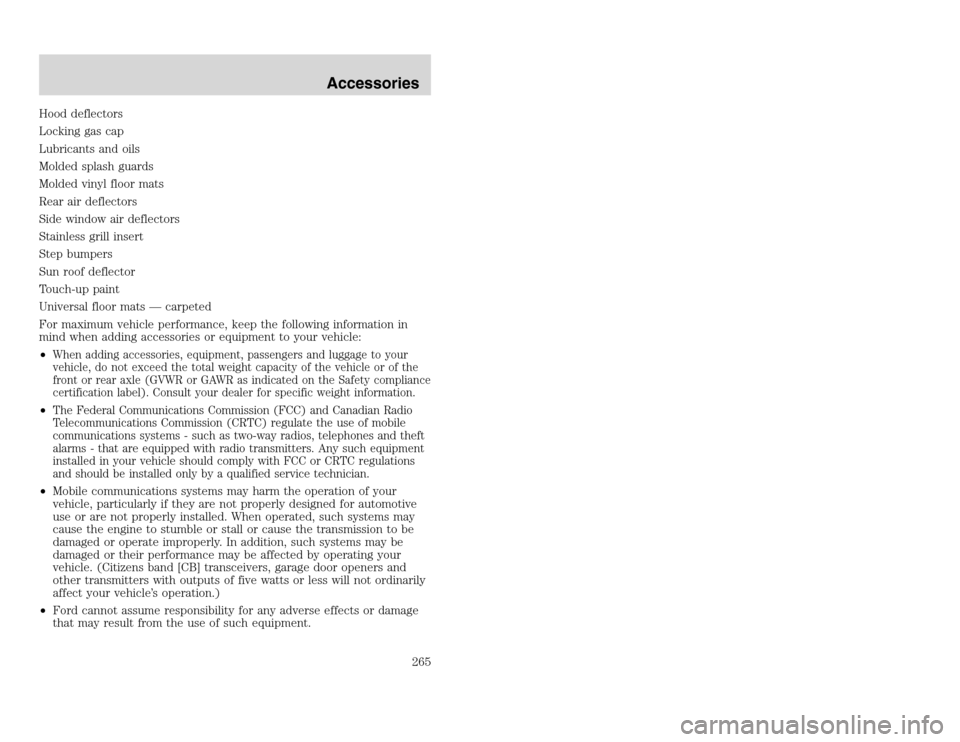
20815.psp Ford O/G 2002 Excursion English 4th Print 2C3J-19A321-HB 04/24/2003 09:14:57 133 A
Hood deflectors
Locking gas cap
Lubricants and oils
Molded splash guards
Molded vinyl floor mats
Rear air deflectors
Side window air deflectors
Stainless grill insert
Step bumpers
Sun roof deflector
Touch-up paint
Universal floor mats — carpeted
For maximum vehicle performance, keep the following information in
mind when adding accessories or equipment to your vehicle:
•
When adding accessories, equipment, passengers and luggage to your
vehicle, do not exceed the total weight capacity of the vehicle or of the
front or rear axle (GVWR or GAWR as indicated on the Safety compliance
certification label). Consult your dealer for specific weight information.
•
The Federal Communications Commission (FCC) and Canadian Radio
Telecommunications Commission (CRTC) regulate the use of mobile
communications systems - such as two-way radios, telephones and theft
alarms - that are equipped with radio transmitters. Any such equipment
installed in your vehicle should comply with FCC or CRTC regulations
and should be installed only by a qualified service technician.
•Mobile communications systems may harm the operation of your
vehicle, particularly if they are not properly designed for automotive
use or are not properly installed. When operated, such systems may
cause the engine to stumble or stall or cause the transmission to be
damaged or operate improperly. In addition, such systems may be
damaged or their performance may be affected by operating your
vehicle. (Citizens band [CB] transceivers, garage door openers and
other transmitters with outputs of five watts or less will not ordinarily
affect your vehicle’s operation.)
•Ford cannot assume responsibility for any adverse effects or damage
that may result from the use of such equipment.
Accessories
265
Hood deflectors
Locking gas cap
Lubricants and oils
Molded splash guards
Molded vinyl floor mats
Rear air deflectors
Side window air deflectors
Stainless grill insert
Step bumpers
Sun roof deflector
Touch-up paint
Universal floor mats — carpeted
For maximum vehicle performance, keep the following information in
mind when adding accessories or equipment to your vehicle:
•
When adding accessories, equipment, passengers and luggage to your
vehicle, do not exceed the total weight capacity of the vehicle or of the
front or rear axle (GVWR or GAWR as indicated on the Safety compliance
certification label). Consult your dealer for specific weight information.
•
The Federal Communications Commission (FCC) and Canadian Radio
Telecommunications Commission (CRTC) regulate the use of mobile
communications systems - such as two-way radios, telephones and theft
alarms - that are equipped with radio transmitters. Any such equipment
installed in your vehicle should comply with FCC or CRTC regulations
and should be installed only by a qualified service technician.
•Mobile communications systems may harm the operation of your
vehicle, particularly if they are not properly designed for automotive
use or are not properly installed. When operated, such systems may
cause the engine to stumble or stall or cause the transmission to be
damaged or operate improperly. In addition, such systems may be
damaged or their performance may be affected by operating your
vehicle. (Citizens band [CB] transceivers, garage door openers and
other transmitters with outputs of five watts or less will not ordinarily
affect your vehicle’s operation.)
•Ford cannot assume responsibility for any adverse effects or damage
that may result from the use of such equipment.
Accessories
265
Page 267 of 272
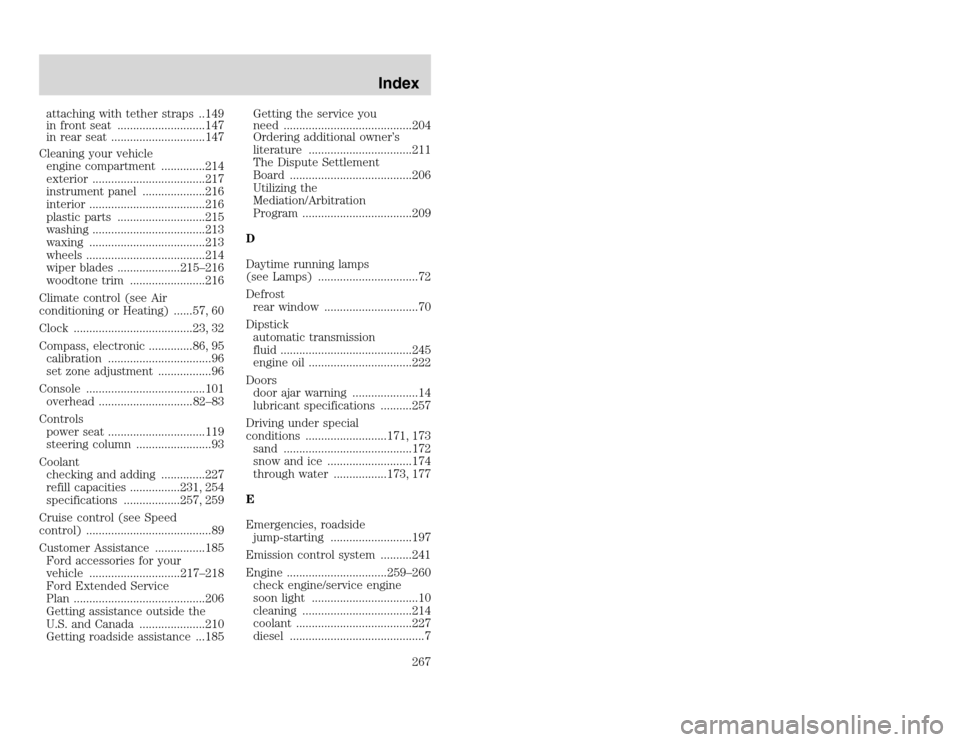
20815.psp Ford O/G 2002 Excursion English 4th Print 2C3J-19A321-HB 04/24/2003 09:14:57 134 A
attaching with tether straps ..149
in front seat ............................147
in rear seat ..............................147
Cleaning your vehicle
engine compartment ..............214
exterior ....................................217
instrument panel ....................216
interior .....................................216
plastic parts ............................215
washing ....................................213
waxing .....................................213
wheels ......................................214
wiper blades ....................215–216
woodtone trim ........................216
Climate control (see Air
conditioning or Heating) ......57, 60
Clock ......................................23, 32
Compass, electronic ..............86, 95
calibration .................................96
set zone adjustment .................96
Console ......................................101
overhead ..............................82–83
Controls
power seat ...............................119
steering column ........................93
Coolant
checking and adding ..............227
refill capacities ................231, 254
specifications ..................257, 259
Cruise control (see Speed
control) ........................................89
Customer Assistance ................185
Ford accessories for your
vehicle .............................217–218
Ford Extended Service
Plan ..........................................206
Getting assistance outside the
U.S. and Canada .....................210
Getting roadside assistance ...185Getting the service you
need .........................................204
Ordering additional owner’s
literature .................................211
The Dispute Settlement
Board .......................................206
Utilizing the
Mediation/Arbitration
Program ...................................209
D
Daytime running lamps
(see Lamps) ................................72
Defrost
rear window ..............................70
Dipstick
automatic transmission
fluid ..........................................245
engine oil .................................222
Doors
door ajar warning .....................14
lubricant specifications ..........257
Driving under special
conditions ..........................171, 173
sand .........................................172
snow and ice ...........................174
through water .................173, 177
E
Emergencies, roadside
jump-starting ..........................197
Emission control system ..........241
Engine ................................259–260
check engine/service engine
soon light ..................................10
cleaning ...................................214
coolant .....................................227
diesel ...........................................7
Index
267
attaching with tether straps ..149
in front seat ............................147
in rear seat ..............................147
Cleaning your vehicle
engine compartment ..............214
exterior ....................................217
instrument panel ....................216
interior .....................................216
plastic parts ............................215
washing ....................................213
waxing .....................................213
wheels ......................................214
wiper blades ....................215–216
woodtone trim ........................216
Climate control (see Air
conditioning or Heating) ......57, 60
Clock ......................................23, 32
Compass, electronic ..............86, 95
calibration .................................96
set zone adjustment .................96
Console ......................................101
overhead ..............................82–83
Controls
power seat ...............................119
steering column ........................93
Coolant
checking and adding ..............227
refill capacities ................231, 254
specifications ..................257, 259
Cruise control (see Speed
control) ........................................89
Customer Assistance ................185
Ford accessories for your
vehicle .............................217–218
Ford Extended Service
Plan ..........................................206
Getting assistance outside the
U.S. and Canada .....................210
Getting roadside assistance ...185Getting the service you
need .........................................204
Ordering additional owner’s
literature .................................211
The Dispute Settlement
Board .......................................206
Utilizing the
Mediation/Arbitration
Program ...................................209
D
Daytime running lamps
(see Lamps) ................................72
Defrost
rear window ..............................70
Dipstick
automatic transmission
fluid ..........................................245
engine oil .................................222
Doors
door ajar warning .....................14
lubricant specifications ..........257
Driving under special
conditions ..........................171, 173
sand .........................................172
snow and ice ...........................174
through water .................173, 177
E
Emergencies, roadside
jump-starting ..........................197
Emission control system ..........241
Engine ................................259–260
check engine/service engine
soon light ..................................10
cleaning ...................................214
coolant .....................................227
diesel ...........................................7
Index
267
Page 270 of 272
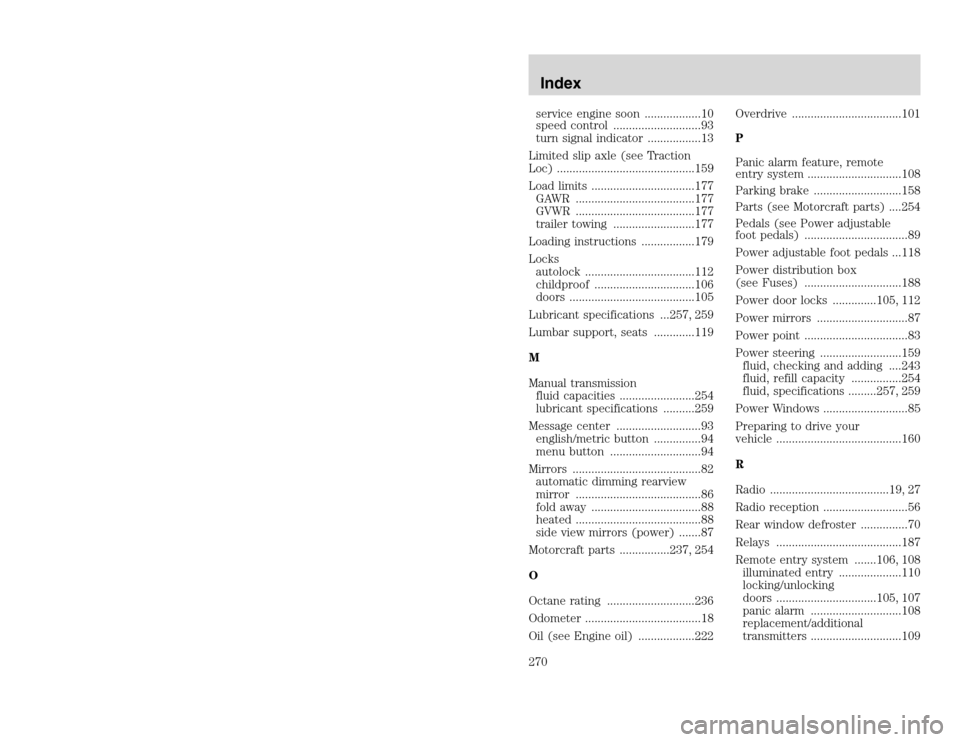
20815.psp Ford O/G 2002 Excursion English 4th Print 2C3J-19A321-HB 04/24/2003 09:14:57 135 B
service engine soon ..................10
speed control ............................93
turn signal indicator .................13
Limited slip axle (see Traction
Loc) ............................................159
Load limits .................................177
GAWR ......................................177
GVWR ......................................177
trailer towing ..........................177
Loading instructions .................179
Locks
autolock ...................................112
childproof ................................106
doors ........................................105
Lubricant specifications ...257, 259
Lumbar support, seats .............119
M
Manual transmission
fluid capacities ........................254
lubricant specifications ..........259
Message center ...........................93
english/metric button ...............94
menu button .............................94
Mirrors .........................................82
automatic dimming rearview
mirror ........................................86
fold away ...................................88
heated ........................................88
side view mirrors (power) .......87
Motorcraft parts ................237, 254
O
Octane rating ............................236
Odometer .....................................18
Oil (see Engine oil) ..................222Overdrive ...................................101
P
Panic alarm feature, remote
entry system ..............................108
Parking brake ............................158
Parts (see Motorcraft parts) ....254
Pedals (see Power adjustable
foot pedals) .................................89
Power adjustable foot pedals ...118
Power distribution box
(see Fuses) ...............................188
Power door locks ..............105, 112
Power mirrors .............................87
Power point .................................83
Power steering ..........................159
fluid, checking and adding ....243
fluid, refill capacity ................254
fluid, specifications .........257, 259
Power Windows ...........................85
Preparing to drive your
vehicle ........................................160
R
Radio ......................................19, 27
Radio reception ...........................56
Rear window defroster ...............70
Relays ........................................187
Remote entry system .......106, 108
illuminated entry ....................110
locking/unlocking
doors ................................105, 107
panic alarm .............................108
replacement/additional
transmitters .............................109Index270
service engine soon ..................10
speed control ............................93
turn signal indicator .................13
Limited slip axle (see Traction
Loc) ............................................159
Load limits .................................177
GAWR ......................................177
GVWR ......................................177
trailer towing ..........................177
Loading instructions .................179
Locks
autolock ...................................112
childproof ................................106
doors ........................................105
Lubricant specifications ...257, 259
Lumbar support, seats .............119
M
Manual transmission
fluid capacities ........................254
lubricant specifications ..........259
Message center ...........................93
english/metric button ...............94
menu button .............................94
Mirrors .........................................82
automatic dimming rearview
mirror ........................................86
fold away ...................................88
heated ........................................88
side view mirrors (power) .......87
Motorcraft parts ................237, 254
O
Octane rating ............................236
Odometer .....................................18
Oil (see Engine oil) ..................222Overdrive ...................................101
P
Panic alarm feature, remote
entry system ..............................108
Parking brake ............................158
Parts (see Motorcraft parts) ....254
Pedals (see Power adjustable
foot pedals) .................................89
Power adjustable foot pedals ...118
Power distribution box
(see Fuses) ...............................188
Power door locks ..............105, 112
Power mirrors .............................87
Power point .................................83
Power steering ..........................159
fluid, checking and adding ....243
fluid, refill capacity ................254
fluid, specifications .........257, 259
Power Windows ...........................85
Preparing to drive your
vehicle ........................................160
R
Radio ......................................19, 27
Radio reception ...........................56
Rear window defroster ...............70
Relays ........................................187
Remote entry system .......106, 108
illuminated entry ....................110
locking/unlocking
doors ................................105, 107
panic alarm .............................108
replacement/additional
transmitters .............................109Index270
Page 272 of 272
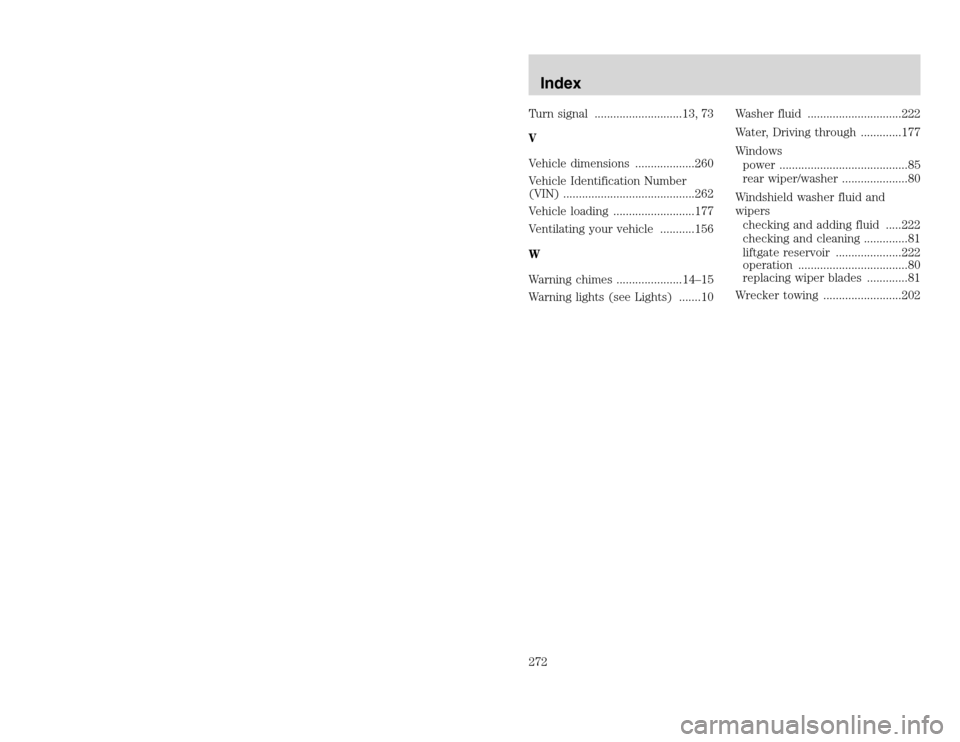
20815.psp Ford O/G 2002 Excursion English 4th Print 2C3J-19A321-HB 04/24/2003 09:14:57 136 B
Turn signal ............................13, 73
V
Vehicle dimensions ...................260
Vehicle Identification Number
(VIN) ..........................................262
Vehicle loading ..........................177
Ventilating your vehicle ...........156
W
Warning chimes .....................14–15
Warning lights (see Lights) .......10Washer fluid ..............................222
Water, Driving through .............177
Windows
power .........................................85
rear wiper/washer .....................80
Windshield washer fluid and
wipers
checking and adding fluid .....222
checking and cleaning ..............81
liftgate reservoir .....................222
operation ...................................80
replacing wiper blades .............81
Wrecker towing .........................202Index272
Turn signal ............................13, 73
V
Vehicle dimensions ...................260
Vehicle Identification Number
(VIN) ..........................................262
Vehicle loading ..........................177
Ventilating your vehicle ...........156
W
Warning chimes .....................14–15
Warning lights (see Lights) .......10Washer fluid ..............................222
Water, Driving through .............177
Windows
power .........................................85
rear wiper/washer .....................80
Windshield washer fluid and
wipers
checking and adding fluid .....222
checking and cleaning ..............81
liftgate reservoir .....................222
operation ...................................80
replacing wiper blades .............81
Wrecker towing .........................202Index272